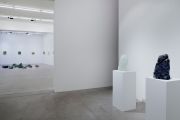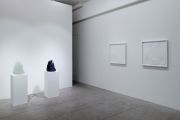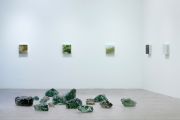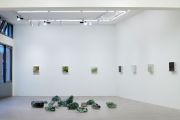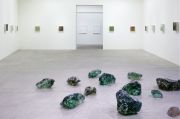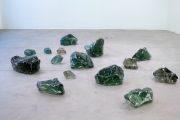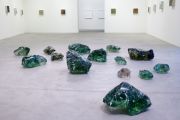Michel Comte
Erosion I
November 21, 2020 – January 29, 2021
Galerie Urs Meile Lucerne
Press Release – English
If you halt the erosion of humankind, humankind will halt the erosion of the soil. – Chandi Prasad Bhatt, environmental activist
One of the most drastic consequences of climate change is massive erosion following extreme weather events. It is the title and leitmotif of Michel Comte’s two exhibitions, Erosion I and Erosion II, which will open this fall/winter at the Galerie Urs Meile in Lucerne and at the artist’s studio in Uetikon am See, Switzerland.
Comte once described his works as “gentle reminders of reality,” as he uses them to draw attention to climate change. His nearly sacred-looking works of art strive to capture the sublimity of what threatens to disappear soon or has already vanished. In the process Comte primarily tries to instigate an awareness of the impacts of our actions on our environment, while inspiring us to lead simpler, more sustainable lives. Only if we change ourselves, our lifestyles, and our consumer behavior will we gain the opportunity to slow the progress of environmental destruction.
Erosion. The eponymous series of works Erosion encompasses 20 ceramic works (2018, porcelain, rock salt, rock dust, and mineral pigments, 33 x 33 x 10 cm each). The darker works are fired with ground rock and coal. Their surfaces are reminiscent of the layer of rust on glaciers, which can be traced back to industrial coal burning that has also been causing the glaciers to melt since the nineteenth century. A mix of salt, rock dust, and pigments lend the lighter works their coloring. The salt refers to the increasing salinization of the oceans, which is occurring due to the change in the hydrologic cycle (evaporation, precipitation, and circulation) cause by global warming. Rock dust is the result of the immense pressure glacial ice exerts upon the boulders below it.
Ombre. (2018, distilled water on handmade, raw rice paper, 66 x 66 cm). Comte had a pigment relief made of each of the 33 x 33 x 10-cm ceramic pieces on handmade rice paper from one of Beijing’s oldest paper manufacturers. Dampened with distilled water, the white rice paper is pressed upon the ceramics for several hours. Pressing the pigment against the surface texture of the blocks for more than seventeen hours results in a permanent image on the paper. The sensuous, delicate paper topographies thus produced resemble endless, snow-covered mountain landscapes.
Drifts. With this installation of sixteen cast glass sculptures measuring 20 to 75 centimeters, Drifts (2020, coldworking glass, variable dimensions), Comte presents his newest series of works. From a distance, the individual pieces look like raw rocks. Seen from close up, however, the fascinating interiors of the sculptures open up to the viewer, revealing a similarity to ice formations or crystals, so that they resemble living creatures created by nature. The title, Drifts, refers to the rocks and sediment that emerge through the erosion, shifting, and debris of glaciers.
Comte’s Drifts are connected to his group of sculptures, Untitled (Murano Glass Mountains, 2017, handcrafted Murano glass, granite dust, 40 x 29 x 20 cm, edition of 2 + I AP), which are also featured in the show. The two pieces, made of handcrafted Murano glass resemble massifs and were first presented in 2017 as part of the exhibition Black Light, White Light at the Triennale di Milano.
Wood Prints. “What would human life be without forests, those natural cities?” asked the American author Henry David Thoreau. With Wood Prints (2020, black ink print on paper, 42 x 29.7 cm each), a series of black Japanese ink woodcuts on paper, Comte’s theme is the die-off of trees in the present time. As a result of environmental changes, commercial exploitation, and systemic neglect of forests, the “lungs of the earth” are in serious danger. Their greatest threats are fires, storms, parasites, unsustainable forestry methods, and extensive logging.
Press Release - Deutsch
„If you halt the Erosion of humankind, humankind will halt the erosion of the soil.“ – Chandi Prasad Bhatt, Umweltaktivist
Eine der drastischen Folgen des Klimawandels ist massive Erosion infolge extremer Wetterereignisse. Sie bildet Titel und Leitmotiv der beiden Ausstellungen Erosion I und Erosion II von Michel Comte, die diesen Herbst/Winter in der Galerie Urs Meile, Luzern, sowie im Atelier des Künstlers in Uetikon am See eröffnet werden.
Erosion. Die titelgebende Werkserie Erosion umfasst 20 Keramikarbeiten (2018, Porzellan, Steinsalz, Steinmehl und mineralische Pigmente, je 33 x 33 x 10cm). Die dunkleren Werke wurden mit geriebenem Gestein und Kohle gebrannt. Ihre Oberfläche lässt an die Rußschicht auf Gletschern erinnern, die vor allem auf industrielle Kohleverbrennung zurückzuführen ist und bereits seit dem 19. Jahrhundert eine Ursache des Gletscherrückgangs ist. Den helleren Werken verleiht eine Mischung aus Salz, Steinmehl und
Pigmenten ihre Farbe. Das Salz verweist auf die zunehmende Versalzung der Ozeane aufgrund des durch die Erderwärmung veränderten Zyklus aus Verdunstung, Niederschlag und Wasserzirkulation. Steinmehl entsteht infolge des hohen Drucks, den Gletscher-Eismassen auf das darunter liegende Geröll ausüben.
Ombre. (2018, destilliertes Wasser auf handgeschöpftem rohem Reispapier, 66 x 66 cm). Von jedem der 33 × 33 × 10 Zentimeter großen Keramikarbeiten ließ Comte ein Pigment-Relief aus handgeschöpftem Reispapier von einer der ältesten Papiermanufakturen Pekings anfertigen. Das mit destilliertem Wasser angefeuchtete, weiße Reispapier wird dazu über mehrere Stunden auf die Keramiken gepresst. Auf diese Weise prägen sich die Oberflächenstrukturen der Blöcke zusammen mit einer Pigmentschicht dauerhaft in das Papier. Die dabei entstehenden sinnlich-filigranen Papier- Topografien erinnern an endlose, schneebedeckte Berglandschaften.
Drifts. Mit der Installation von 16 gegossenen, 20 bis 75 Zentimeter grossen Glasskulpturen Drifts (2020, kaltbearbeitetes Glas, Grössen variieren) präsentiert Comte seine neueste Werkserie. Aus der Distanz wirken die einzelnen Arbeiten wie rohes Gestein. Aus der Nähe betrachtet eröffnet sich dem Betrachter jedoch das faszinierende Innenleben der Skulpturen das an Eisgebilde oder Kristalle erinnert und sie wie lebendige, von der Natur geschaffene Wesen wirken lässt. Der Titel Drifts bezieht sich auf Gestein und Sedimente die durch Erosion, Transport und Ablagerung durch Gletscher entstanden sind.
Comtes Drifts schließen an seine Skulpturengruppe Untitled (Murano Glass Mountains, 2017, handgemachtes Muranoglas, Granitstaub, 40 x 29 x 20 cm, Edition von 2 + I AP) an, die ebenfalls Teil der Ausstellung ist. Die zwei aus Muranoglas, handgefertigten Arbeiten erinnern an Bergmassive und wurden
2017 in der Ausstellung Black Light, White Light im Triennale di Milano präsentiert.
Wood Prints. „What would human life be without forests, those natural cities?“ fragte bereits der amerikanische Schriftsteller Henry David Thoreau. Mit Wood Prints (2020, schwarzer Tintendruck auf Papier, je 42 x 29.7 cm) einer Serie von schwarzen Japantusche-Abdrucken von Holzblöcken auf weißem Papier, thematisiert Comte das gegenwärtige, weltweite Baumsterben. Infolge von Umweltveränderungen, kommerzieller Ausbeutung und systematischer Vernachlässigung der Wälder ist die Lunge der Erde in ernster Gefahr. Ihre größten Bedrohungen sind Brände, Stürme, Parasiten, unnachhaltige Forstwirtschaft und Massenabholzung.
DOWNLOADS
Press Release (English, PDF)
Press Release (Deutsch, PDF)
EVENTS
Opening:
Saturday, November 21, 2020, 11am - 5.00pm

